Itinerary: PoMo in New Zealand
In this month's itinerary, supported by Dulux Colours of New Zealand, Andrew Barrie and Julia Gatley call attention to 14 Postmodern buildings in New Zealand and discuss their unique position in society.
Postmodern architecture stretched, questioned and challenged the aspirations of modernism, from ethics and rationality to transparency and abstraction. For many, Robert Venturi’s “gentle manifesto”, Complexity and Contradiction in Architecture (1966), provided the intellectual arguments. The ruptures that had characterised modernism — that is, the rejection of history, decoration, symbolism, narrative and metaphor — were to be restitched, resulting in Venturi’s “difficult unity of inclusion rather than the easy unity of exclusion”. Put more simply, he advocated for “both/and” rather than “either/or”. References to historical forms (especially classical forms) were readmitted to architectural vocabularies, joined by sunny colours, glamorous neon and shiny things like chrome. Architecture became extraverted, witty and playful; it became populist rather than elitist.
Despite the differences between modernism and postmodernism, the line between them is sometimes blurry. At the levels of construction and structure, for example, the two are often no different. And in the late 1960s and 1970s, Ian Athfield and Roger Walker questioned and challenged almost everything, but, in an excellent survey of New Zealand modernism (docomomo Journal, September 2003), Paul Walker makes the important point that they “retained the belief that architecture could be the vehicle of a general amelioration of the social realm” — one of the key attributes of modernism.
In fact, one of PoMo’s unusual characteristics was that so many of its key figures were celebrated modernists at earlier stages in their careers. Whereas new ideas are typically championed by youngsters looking to distinguish themselves from the previous generation, around the world, PoMo was led by established figures jettisoning their former modernist selves — Philip Johnson in the US, James Stirling in the UK and Arata Isozaki in Japan. In New Zealand, the same can be said of heavyweights like Warren and Mahoney, McCoy and Wixon, and Structon Group, among others.
Youngsters contributed through houses, with members of the Ponsonby collective Artifice achieving prominence by marrying high ideas and low means: Mal Bartleet’s Murphy House (1983; pediments and wooden trellis), Pete Bossley’s Glock House (1984; pastels and polycarbonate) and Pip Cheshire’s Vernon Townhouse (1985; cubism and coloured tiles). The most significant house of all was the Gibbs House in Parnell (1984) by Manning Mitchell, the house capturing, according to Douglas Lloyd Jenkins, the “[g]lamour, excitement and a sense of connection to the wider world [that] New Zealanders were seeking after the isolation of the Muldoon years.”
PoMo is associated with the economic boom and rapid globalisation resulting from the neoliberal reforms of Ronald Reagan and Margaret Thatcher, and, here in Aotearoa, David Lange’s Labour government and Rogernomics. It was a period of rapid inflation — 15.7 per cent in 1987. Runaway costs meant developers pushed architects to work with unseemly speed, often at the expense of design quality. The bubble was burst by the stockmarket crash of October 1987. Many projects stopped dead, leaving our central cities littered with car parks where old buildings had been hastily bulldozed. Some projects limped on, completed in the early 1990s, by which time a more sober approach had taken hold. Oddly, it was still a historicism but one that looked to modernism, rather than back over it to its predecessors.
Our PoMo architecture was given its fullest expression during an era of demolition; ironically, it is now being subject to the same forces. The quakes wiped out Warren and Mahoney’s Christchurch PoMo projects, and Athfield Architects’ work in Wellington has taken a particular hit, with Arlington Housing (1970–1978; with King & Dawson, including George Porter Towers) and the First Church of Christ Scientist (1980–1983) demolished in recent years. But Athfields’ Wellington Central Library (1988–1991) was saved. PoMo has been through a period of unpopularity. An appreciation of history, which drove many of these projects, is needed if more of the best are to survive long term.
THE ITINERARY
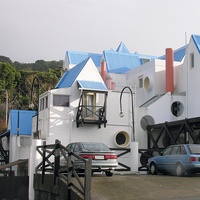
1. 1974 — Park Mews
62 Moxham Avenue, Wellington
Roger Walker
Park Mews is perhaps the fullest expression of the unlikely layering of references to colonial cottages and Japanese metabolism for which Roger Walker’s early work is well known, combined with an overall complexity and liveliness. While such work is quite different from the PoMo architecture of the 1980s, these attributes nonetheless signal the transition away from the clean lines of modernism and, certainly, the sense of fun is to the fore. Colour was important to the original design, with red for many of the steep roofs and yellow for the circular windows and diagonal bracing.
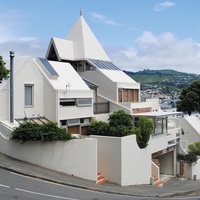
2. 1980 — Pearce Apartments
100 Marjoribanks Street, Wellington
Athfield Architects
Ath had long-standing interests in housing, as distinct from houses. He found a like-minded client in engineer Bill Pearce, who admired Moshe Safdie’s work, including Habitat 67 in Montreal. The Pearce Apartments took 12 years from design to completion. The Wellington City Council declined an early scheme for a tower, agreeing to eight units, which morphed into six after construction had started. The complex demonstrates Ath’s questioning of the open spaces of modernism and his commitment to giving architectural expression to a range of smaller spaces under a complex array of roofs and balconies.
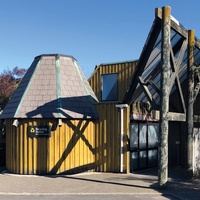
3. 1981 — Wairakei Resort Taupō
640 Wairakei Drive, Taupō
Roger Walker
The tourism industry was a key source of projects for Walker and he designed a number for the Tourist Hotel Corporation: staff housing (1982) tucked behind The Chateau on Mount Ruapehu, a now much-altered hotel in Queenstown (1989) and various facilities (a laundry, spa, toilets and villas) at this hotel outside Taupō. Only a few shifts from Walker’s earlier approach – the addition of trellis and polycarbonate to the material palette, a reorientation from colonial towards classical references, slightly flatter and more graphic manipulation of façades – would bring his work into alignment with the bold postmodernism then emerging from Europe and the US.
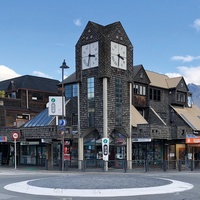
4. 1984 — Clock Tower Building
42 Camp Street, Queenstown
John Blair, Architect
Blair was one of the nation’s most exciting architects of the 1970s and 1980s, though his work has somewhat faded from our collective historical consciousness following his retirement, perhaps because he operated largely outside the main centres. His early work was highly geometric and sculptural, and, in the 1980s, his work shifted slightly, absorbing a new set of influences. Blair’s Clock Tower Building adopts the references popularised by American historian Vincent Scully’s 1974 book The Shingle Style Today, part of a wider Victorian revival. As in the US, the woody shingle style seemed to have special appeal for postmodernists working in dramatic landscapes.
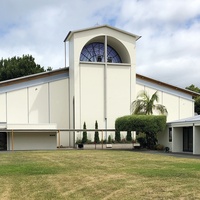
5. 1984 — St Patrick’s Church
4 Munroe Street, Napier
Warren and Mahoney
Approached across an ātea-like forecourt, this calm composition is all arches, barrel vaults and classical proportions. Within, a disciplined arrangement of concrete columns, timber trusses and clerestory light calls back to Warren and Mahoney’s best high modern work. See Architecture NZ July/August 1984. St Patrick’s is a high point of local postmodern classicism, a broad strand in Warren and Mahoney’s oeuvre that includes the Rotorua Civic Centre (1985) and the Royal Oak Shopping Mall in Auckland (1988). Warren and Mahoney’s Salvation Army Citadel at 92 Vivian Street, Wellington, (1991) is wilder: a late flurry before the practice began to set classicism aside.
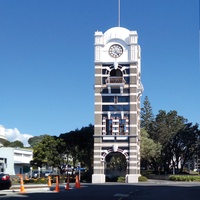
6. 1985 — Clock Tower
2 Robe Street, New Plymouth
Boon, Goldsmith & Company
Paul Goldsmith (b. 1948) partnered with Terry Boon (b. 1938), who was the same generation as Ian Athfield (b. 1940), David Mitchell (b. 1941), John Blair (b. 1942) and Roger Walker (b. 1942). The firm’s early work was expressive modernism — Goldsmith’s New Plymouth Telephone Exchange (1982; 92 Liardet Street) is a gem. Goldsmith’s tower rehoused a clock from the city’s 1907 Post Office, marrying the stripy classicism of the now-demolished Post Office with glassy bits described at the time as ‘high tech’. One of our most eye-popping PoMo projects, it now seems calm against the visual ‘zizz’ of Patterson Associates’ Len Lye Centre (2015) across the road. Refer Architecture NZ May/June 1986.
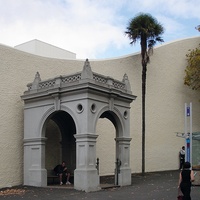
7. 1986 — University of Auckland School of Music
6 Symonds Street, Auckland
Hill Manning Mitchell
This building is a collection of references, allusions and quotations. The sources span the range from the world of music to international architecture to local buildings: sine curves and piano-lid shapes; entrance porticoes retained from previous buildings on the site; vernacular shed forms. Underlying the postmodern collaging is a concern for climate and usage. The building’s more public spaces — library, reception, music theatre — are arranged around an intimately scaled cloister and courtyard overlooked by balconies and seating areas. The bright, open foyer is one of the city’s most dynamic public spaces. The building received an NZIA National Award in 1987. See NZ Architect Nov/Dec 1986.
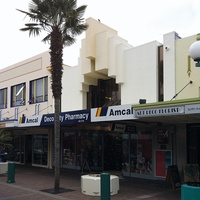
8. 1986 — UFS Dispensary
265 Emerson Street, Napier
Hoogerbrug Magdalinos Williams
Unsurprisingly, the references on this Napier dispensary’s façade are not to classical architecture but to art deco. Contentious in its time, this project required the demolition of a Spanish Mission-style building that was the subject of a preservation campaign by local art-deco enthusiasts, but the dispensary has since become a landmark in Napier’s retail centre. Douglas Lloyd Jenkins described it as a “superbly sophisticated example of a small-scale, postmodern building” and it was recognised with an NZIA National Award in 1987 — PoMo maestro Paris Magdalinos’ first National award. See Home & Building Dec 1987/Jan 1988.
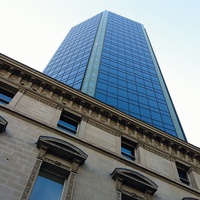
9. 1987 — BNZ Tower
125 Queen Street, Auckland
Walker Co-Partnership
The original Bank of New Zealand building was designed by Melbourne architect Leonard Terry in 1865, just four years after the bank was founded. Terry’s Renaissance Revival façade stood out as one of the first stone buildings in a largely wooden town. The building was subjected to one of the most controversial 1980s’ practices — façadism. Those in favour argued that this was the only economically feasible way in which heritage could be retained, while critics of the BNZ project described the retained bank façade as an “unburied corpse”. See Historic Places in New Zealand June 1987 and Home & Building Feb/Mar 1987.
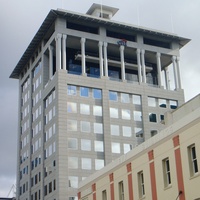
10. 1989 — Citibank Centre
23 Customs Street, Auckland
Warren and Mahoney
Office towers formed a big portion of Warren and Mahoney’s output from the early 1970s, with the firm’s designers embracing a postmodern classicist language for many (though not all) of its commercial buildings from the mid-1980s. The Citibank Centre, with its exposed aggregate panels and colonnaded sky terrace, was at the serious end of Warren and Mahoney’s classical spectrum: a missing link to elegant concrete-clad brutalist towers of the 1970s. Other towers, many now demolished, had pastels and pediments aplenty — the best survivors include 80 The Terrace (1989), 49 Boulcott Street (1989) and the Mercer Tower on Mercer Street (1989), all in Wellington.
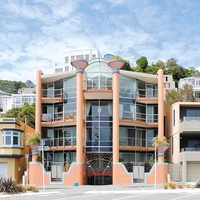
11. 1989 — Oriental Bay Apartments
226 Oriental Parade, Wellington
Athfield Architects
Developed by Cromwell Corporation Ltd, this luxury apartment building is one of New Zealand’s most overt expressions of PoMo historical referencing and manipulation. It has the symmetry and axiality of classicism, with oversized columns that support brass planter boxes rather than concentrating on a column’s traditional job of load-bearing. A bold colour scheme of apricot and green heightens the effect. The sharemarket crash impacted sale prices and developer profits. Athfields’ PoMo repertoire in Wellington also included the owl-like Skyline Restaurant (now Cable Top), 1 Upland Road (1982–1984), and Telecom House, 13–27 Manners Street (1986–1988).
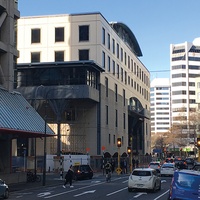
12. 1991 — Wellington Central Library
Cnr Victoria and Harris Streets, Wellington
Athfield Architects
Famous for its nikau palm columns, the Central Library also contributes to the enclosure of Wellington’s Civic Square. It combines solidity and mass on the Victoria Street side with transparency and curves on the Civic Square side. Permeability was central to its success. Seismic concerns and the threat of demolition in 2019 triggered a campaign to save it. The City Council took heed, commissioning Athfield Architects to lead its revitalisation. It is now PoMo heritage, having been listed as a Category 1 historic place in 2021. It is expected to reopen in 2026.
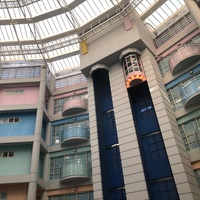
13. 1991 — Starship Hospital
Park Road, Auckland
Stephenson & Turner
The brief for this building required that it have “character and personality” and “should be clearly for children”. Designed to cast off institutional scale and appeal to sick kids, the project exaggerated some of the more cartoonish aspects of PoMo formmaking to create a playful and colourful environment. To humanise the building further, it was planned around a striking 33m-high atrium, configured to maximise natural lighting and ventilation. The colours on the exterior have been altered but the atrium is still largely original — a pastel Piranesi. See Architecture NZ Sept/Oct 1988 and Jan/Feb 1992, and Home & Building Feb/Mar 1992.
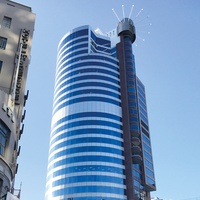
14. 1991 — The Majestic
88 Willis Street, Wellington
Manning & Associates and Jasmax
The Majestic replaced Wellington’s old Majestic Theatre, demolished in 1987. The building was briefly the country’s tallest, the pathos of a record only momentarily held seeming apt for a project that represents the last flickers of Kiwi PoMo — the tower was one of the large commercial projects not curtailed by the 1987 stockmarket crash. It is an exercise in postmodern pluralism, knitting together a high-tech glazed entry, classical motifs, modernist bits and two historic buildings on the street frontage. It earned an NZIA National Award in 1992. See Architecture NZ Jul/Aug 1991 and May/June 1992.
OTHER ADDRESSES
Napier Street Townhouses (1982)
Napier Street, Freemans Bay, Auckland
Cook Hitchcock Sargisson
99 Boulcott Street (1983)
99 Boulcott Street, Wellington
Craig Craig Moller
68 Dixon Street (1984)
68 Dixon Street, Wellington
Craig Craig Moller
St Mary’s College (1986)
15 Guildford Terrace, Wellington
Structon Group
Various campus projects were completed through the 1980s.
Hewlett Packard Building (1987)
186–190 Willis Street, Wellington
Athfield Architects
Symonds Centre and O’Rorke Hall (1989)
47–51 Symonds Street, Auckland
Stephenson & Turner
British High Commission (1990)
44 Hill Street, Wellington
Structon Group
HQ for Southland Building and Investment Society (1993)
51 Don Street, Invercargill
Barclay Architects and Baxter Hesselin McDowell Architects
Perhaps the world’s southern-most example of postmodern classicism.
SOURCES
The international books mentioned are Robert Venturi’s Complexity and Contradiction in Architecture (New York: MoMA, 1966), Vincent Scully’s The Shingle Style Today (New York: George Braziller, 1974) and Charles Jencks’ The Language of Post-Modern Architecture (New York: Rizzoli, 1977), updated and reissued a number of times up until 1991. Closer to home, David Mitchell and Gillian Chaplin’s The Elegant Shed: New Zealand Architecture since 1945 (Auckland: Oxford University Press, 1984) devotes a long, last chapter to an insightful analysis of the new ideas then being absorbed. Dismay at some of the products of the boom is apparent in Gerald Melling’s The Mid-City Crisis and Other Stories (Wellington: Thumbprint, 1989). Peter Shaw’s A History of New Zealand Architecture (Auckland: Hodder Moa Beckett, 1991) places PoMo in its historical context and Douglas Lloyd Jenkins’ At Home: A Century of New Zealand Design (Auckland: Godwit, 2004) is great on the houses. See also Giles Reid and Chad McMan’s insightful article on some lesserknown Kiwi PoMo practitioners: ‘Once more, with feeling’, Architecture NZ Sept/Oct 2019.












